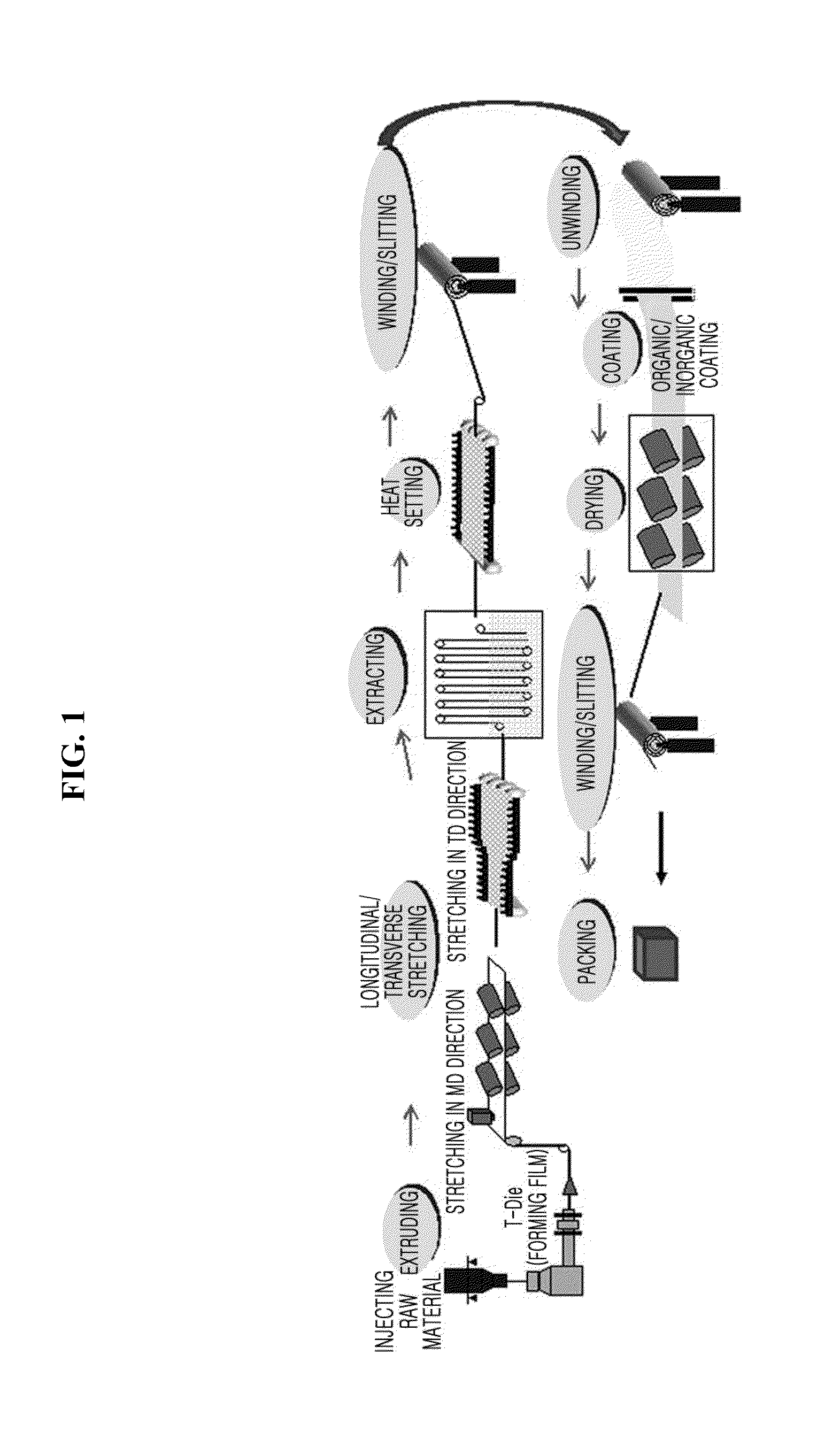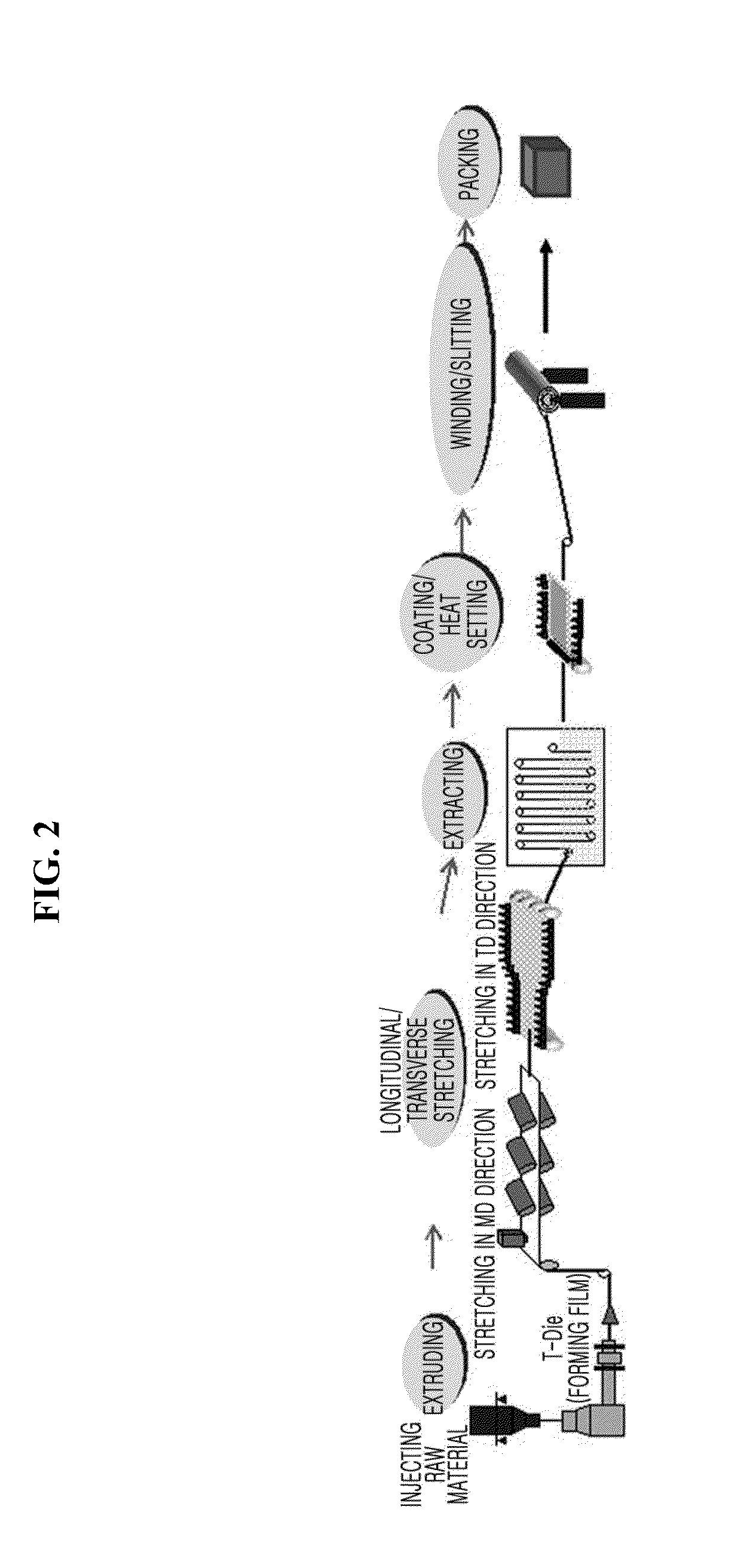Separator for electrochemical device
a technology of electrochemical devices and separators, which is applied in the direction of electrochemical generators, cell components, cell component details, etc., can solve the problems of very severe change in fibril morphology on the surface, negative influence on cycle characteristics, etc., and achieves the reduction of porosity, final thickness, and mechanical strength.
- Summary
- Abstract
- Description
- Claims
- Application Information
AI Technical Summary
Benefits of technology
Problems solved by technology
Method used
Image
Examples
example 1-1
Manufacture of Separator
[0143]High density polyethylene with a weight average molecular weight of 500,000 as polyolefin and liquid paraffin with a kinematic viscosity of 68.00 cSt as a diluent were extruded using a weight ratio of 35:65 at the temperature of 210° C. Stretching was performed at a stretching temperature of 115° C., and a stretch ratio of seven times each in a longitudinal direction and a transverse direction. Subsequently, the diluent, i.e., the liquid paraffin was extracted using methylene chloride as an extraction solvent under the condition of 2 m / min to obtain a porous polyolefin film with an average pore size of 0.04 μm.
[0144]Subsequently, Al2O3 particles with an average grain diameter of 0.5 μm / cyanoethylpolyvinylalcohol (Cyano resin CR-V, Shin-Etsu Chemical, Ltd.) / PVDF-HFP5 (LBG2, Arkema, Inc.) / acetone was mixed at a weight ratio of 18.0 / 0.3 / 1.7 / 80 to prepare a slurry for forming a porous layer.
[0145]The slurry was coated in a thickness of 3.5 μm on one surface...
example 1-2
Manufacture of Separator
[0146]A separator was manufactured by the same method as Example 1-1, except that the slurry was coated in a thickness of 4.0 pin on both surfaces and a thickness of the separator is 19.0 μm. The porous coating layer of the separator has an average pore size of 0.4 μm and an average porosity of 55%.
example 1-3
Manufacture of Cylindrical (18650) Secondary Battery
[0147]Ethylene carbonate, propylene carbonate, and methyl ethyl carbonate compounds were used at a composition ratio of 20 / 10 / 70 based on a volumetric ratio. Subsequently, LiPF6 as a lithium salt was added to a concentration of 1.0M to obtain a non-electrolyte solution.
[0148]With the use of a ternary system cathode material (LiNi1 / 3CO1 / 3Mn1 / 3O2) as a cathode active material, a cathode mixture including 1.3 wt % of Super-P (registered trademark) as a conductive material, 1.8 wt % of PVDF(KF1100 binder), and 0.4 wt % of Li2CO3(lithium carbonate) as an additive was added to a solvent NMP(N-methyl-2-pyrrolidone) to prepare a cathode slurry with solids of 75%, which was then coated on an aluminum current collector to manufacture a cathode.
[0149]With the use of graphite as an anode active material, 0.7 wt % of Super-P (registered trademark) as a conductive material, approximately 0.9 wt % of a SBR binder, and approximately 0.9 wt % of a ...
PUM
| Property | Measurement | Unit |
|---|---|---|
| Temperature | aaaaa | aaaaa |
| Fraction | aaaaa | aaaaa |
| Thickness | aaaaa | aaaaa |
Abstract
Description
Claims
Application Information
 Login to View More
Login to View More - R&D
- Intellectual Property
- Life Sciences
- Materials
- Tech Scout
- Unparalleled Data Quality
- Higher Quality Content
- 60% Fewer Hallucinations
Browse by: Latest US Patents, China's latest patents, Technical Efficacy Thesaurus, Application Domain, Technology Topic, Popular Technical Reports.
© 2025 PatSnap. All rights reserved.Legal|Privacy policy|Modern Slavery Act Transparency Statement|Sitemap|About US| Contact US: help@patsnap.com



